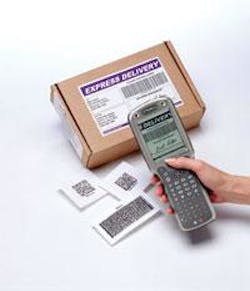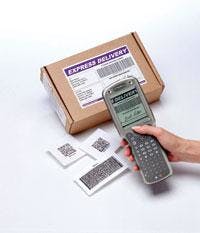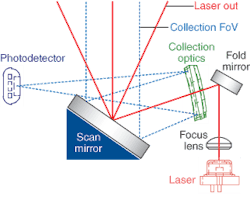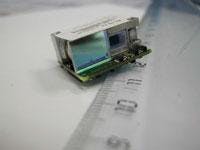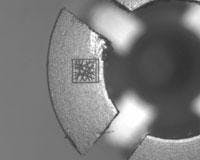Barcode scanners aren’t just for groceries anymore
Barcode scanning-also known as “automated identification and data capture”-has moved way beyond its retail and manufacturing roots.
Barcode scanners have become so ubiquitous in our day-to-day lives that most of us hardly notice them anymore, let alone ponder what makes them tick. This technology began revolutionizing the retail market in 1974, when a checker at a supermarket in Troy, OH, slid a pack of gum imprinted with a simple linear barcode over a fixed scanner to ring up the price. Thirty years later barcodes are scanned about five billion times a day, and are used as much for tracking packages by the likes of FedEx and UPS as they are for ringing up purchases at WalMart or Home Depot.1 Other iterations of the codes can be found on airline and concert tickets, drivers’ licenses, library books, hospital wristbands . . . the list of products bearing these black-and-white symbols is nearly endless, and still growing.
But barcodes are not just consumer-based point-of-service tools; they actually have their roots in manufacturing and distribution. According to Doug Hall, director of product marketing at Intermec (Everett, WA), barcode scanners emerged 35 years ago on the factory floor for ensuring the accuracy of inventory. Today these symbols are a standard part of virtually every product or package in a warehouse or on a loading dock, ensuring that the correct item is delivered to the correct location in a timely manner.
“Our industry started with the invention of the first barcode label printer and the first scanner that could differentiate between dark and light and different widths of bars and encoding of information,” Hall said. “Our culture has had labels for a century or two, and we have always shipped things, but now it has come down to the ability to print a label on command that is self-adhesive and contains both human-readable and machine-readable information.”
In fact, barcodes are being used in many industries outside retail and manufacturing, particularly for quality-control and security applications. In an effort to improve patient care, for example, hospitals are investing in barcode scanners to lower the risk of medication errors, and the U.S. Food and Drug Administration now requires drug makers and blood suppliers to include barcodes on most of their products within two years. In addition, some educational institutions are implementing barcodes on student and faculty identification cards to improve campus security and communication-and most airlines now offer “ticketless” tickets printed with 2-D barcodes that streamline the check-in process and allow security personnel to quickly verify the identity of passengers and their baggage.
“Retail is still the primary market, along with industrial manufacturing, transportation, and logistics,” said Bennett Mason, senior market research analyst at Venture Development (Natick, MA), which has been tracking the barcode industry for 20 years. “But the technology is maturing and the price is coming down, so we are seeing growth in other market segments . . . even people in office situations are starting to use barcodes for filing purposes. The (lower) price makes it worthwhile to eliminate mistakes.”
Beyond the linear boundary
Barcode scanners generally fall into two categories: handheld and stationary. Handheld scanners include laser scanners, linear imagers (with LEDs as the primary light source), 2-D imagers, and pen scanners. Stationary systems range from industrial lasers and imagers to point-of-service scanners and barcode verifiers. The most familiar are those we see everyday in the consumer realm: the one-dimensional linear codes that contain specific information about the product or account they are attached to. These alternating dark and light lines of varying thickness and spacing are typically read with a scanner containing a 1-mW, 650‑nm diode laser (earlier versions used HeNe lasers) and various combinations of optical, electronic, and mechanical components and image-processing software.
Although simple and cost-effective to implement, 1-D barcodes are limited in the amount of data they can contain by the size of the product they are printed on and the linearity of the code itself. With the growing pressure for factories, shipping companies, retail outlets, government agencies, and hospitals to better track and trace their inventory and monitor and protect their customers, increasingly sophisticated barcode symbologies and scanners are now needed. Thus, Symbol, Intermec, and others have also invested in linear and 2-D symbols and scanners that offer greater functionality than traditional 1-D scanners.
In a 2-D barcode, the information is stacked or arranged in an array of dark and light square pixels that can hold more than a kilobyte of machine-readable data and are scanned both horizontally and vertically. Standard 2-D barcodes such as DataMatrix, PDF417, and Aztec are smaller and more flexible than their 1-D counterparts, making them more amenable to applications such as hospital wristbands while also boosting their anticounterfeiting capabilities. In addition, the scanners required to read them typically offer more-advanced imaging capabilities such as optical character recognition, signature capture, and image capture via embedded CCD or CMOS cameras.
Two-dimensional imaging can store significant amounts of data locally on a single package, item, or circuit board and also take a picture, according to Mike Ehrhart, chief technology officer of Hand Held Products (HHP; Skaneateles Falls, NY). The company, a spinout of Welch Allyn, got its start in pen-based scanners but today uses 2-D CMOS sensors in its handheld scanners to collect 1-D and 2-D barcode data and also provide proof of delivery (see Fig. 1). According to Ehrhart, the secret with 2-D imagers has less to do with the camera or hardware and more to do with the imaging software that finds the barcode in the image and decodes it. The camera itself is basically the same as that in a standard cell phone.
DataLogic’s automated 2-D fixed-position scanners are bolted in place on a manufacturing or assembly line and operate unattended at about 400 scans/s, vs. 20 to 40 scans for low-end handheld readers. The company also offers LED- and CCD-based area imagers that take a picture of an area on a product and then decode the barcode from the picture. The company’s highest-end CCD imager uses cameras to read 1-D and 2-D images on all six sides of a carton as it passes by at speeds of 500 ft/min.
“Our fixed systems use a longer-life, more-durable laser diode, and we apply more power to the laser to achieve greater depth of field, longer-distance reading, and wider reading area,” said Grant Grooms, national sales manager for Datalogic in North America. “We modulate the power to gain different effects using built-in automated gain-control systems. We also use a pulse-modulated laser in the fixed-position scanners to measure the distance from the laser output window to the surface where the barcode is, enabling real-time high-speed autofocus of the beam.”
A stronger engine
Other companies are also working to refine the laser-scanning engines to make them more accurate and robust. Symbol Technologies (Holtsville, NY) has long been the leader in the barcode industry in the development of symbologies and scanning engines. Among other things, Symbol invented, patented, and licensed the “dithering mirror” process still used in most barcode scanners. The laser scanner produces a single line that can be created by a rotating, multisided mirror or by a dithering mirror that oscillates back and forth (see Fig. 2).
“For 15 years now we have had devices for scanning the lasers that are designed for infinite operating life, and recently we came out with a new design that is smaller, less expensive, and more durable,” said Bill Callahan, director of strategic marketing for Symbol. “We also continue to improve the signal-processing software and electronics that directly affect the scanner performance, plus proprietary ways to focus the laser at further distances.”
Intermec is working to challenge Symbol’s lead in the scanning-engine business with a MEMS-based barcode scanner developed in conjunction with researchers at the Fraunhofer Institute for Photonic Microsystems (Dresden, Germany; see Fig. 3). The company says MEMS technology produces a laser scan engine with faster scan rates, miniaturization, improved durability, and frictionless mechanical parts. The MEMS design also allows high-speed scanning in two dimensions, omnidirectional reading of 1-D and stacked barcodes, and 2-D raster scanning for matrix codes.
“The advantages of MEMS are that it is solid-state, which means it has less chance of failing and lends itself to mass production,” Hall said. “The mirror is made to oscillate 250 times/s and starts at 400 scans/s but can go up to 5000 scans/s, while conventional electromechanical mirrors operate at 30 to 40 scans/s.”
However, Callahan says that Symbol’s technology offers better signal quality and working range and is slightly less expensive and more reliable than Intermec’s MEMS-based scanners.
“If you use MEMS you need a separate optical system to collect the light, in addition to the optical system that projects the light,” he said. “This is one way to go, but not the best way to make a scanner because it doesn’t allow you to optimize the receiving signal. We use a larger scanning mirror than is possible to create using MEMS, which means we can collect the light off the same mirror and then concentrate the photodetector wherever the laser beam happens to be pointing at the moment. In the Intermec design there is a second mirror that does not move so it has to have a very large field of view, which means it collects not only the reflected laser light but also a lot of ambient light. And that is noise as far as the scanner is concerned.”
Better security
Despite all of these advances, concerns remain that the very ubiquity that has enabled 1-D and 2-D barcodes to become such effective tracking and tracing tools also makes them more vulnerable to security breaches and counterfeiting. Increasing pressure to ensure the country of origin for products and the authenticity of those products is pushing businesses to adopt more-sophisticated tracking technologies. Next-generation technologies such as RFID (radio-frequency identification, in which data is stored and retrieved via tags that contain antennae to receive and respond to queries from an RFID transceiver) are designed to further increase the amount and complexity of data that can be encoded, the security of that data, and the authenticity of the item the code or chip is attached to. But while there has been much speculation that RFID might eventually replace conventional barcodes, the general consensus is that the two methods will remain complementary for many years to come.
“We see RFID as just another data-capture modality,” Callahan said. “It has its advantages, but there will be a period of time, probably a very long period, where they will have to coexist. Barcodes are basically free, but RF tags are not and probably never will be.”
In the meantime, a new 2-D coding scheme being commercialized by Orbid (San Francisco, CA) promises to enhance what barcodes can do in terms of security. The company’s 2DMI technology uses image-recognition algorithms and chaos theory to convert binary or alphanumeric information into a rectangular or square pattern of intersecting lines that can be printed or etched onto a product’s surface (see Fig. 4). The position, angle, and thickness of the lines combine to carry the coded information, with almost infinite combinations available. Each licensed user of 2DMI is supplied with a unique algorithm; anyone not equipped with that algorithm cannot read or copy the code. Other advantages include the ability to create smaller marks and to reconstruct a mark if it is damaged or partially obliterated.
“Most of the symbologies out there have been developed over the years and are in the public domain,” said Kevin Simmons, director of sales for Orbid. “There hasn’t been a lot of R&D into enhancing those codes to be able to handle some of the applications that are coming, such as micro and nanotechnologies and very small, very expensive parts that need to be tracked. So we have attacked this from the standpoint of microcoding parts and products to enable a company to track the smallest items they have down to the unit level without opening themselves up their intellectual property to counterfeiting.”
The company is initially targeting industries in which piracy, counterfeiting, and related security issues are an increasing problem. These include pharmaceuticals, luxury goods, medical devices, and liquor.
REFERENCE
1. N. Varchaver, Fortune (May 17, 2004).
